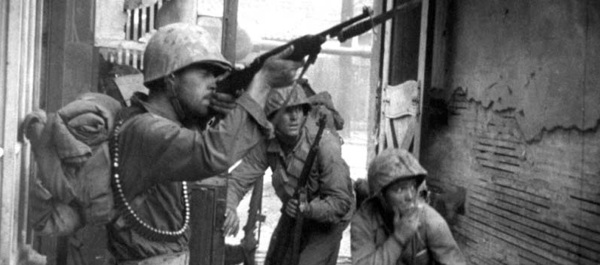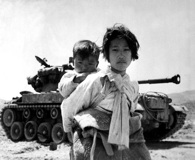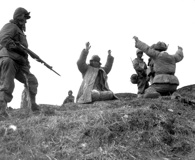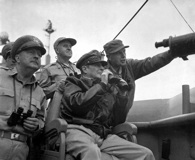ACG Salutes the Korean War 60th Anniversary

It has been nicknamed “The Forgotten War” by those who fought it, since many Korean War veterans feel that their service has either been unfairly ignored or not been adequately recognized. Yet, the courage and sacrifice shown by the U. S. Soldiers, Marines, sailors and airmen, fighting alongside Republic of Korea (ROK) troops and those of 22 United Nations countries deserves our highest respect and admiration. In this 60th anniversary year of the beginning of the Korean War, Armchair General salutes all of our veterans of that conflict.
{default}The Korean War was the first major U. S. military conflict during the Cold War (1947–91) and the first one to erupt after World War II. In fact, many Americans who fought in Korea were World War II vets, and the weapons, equipment and tactics they used were virtually the same as those in the 1941–45 global war. U. S. President Harry S. Truman termed the Korean War a “police action” intended to force the war’s aggressor, North Korea, to abide by international law. Truman also kept the war “limited” to Korea and did not use all weapons in America’s arsenal (such as atomic bombs). Truman’s greatest fear was that the Korean War might spread to become a general war in Asia, while he worried about what retaliation Stalin’s Soviet Union might take in Europe, still recovering from the ravages of World War II. Therefore, after the Korean War’s first year, it became a Limited War to restore the pre-war status quo, not a traditional Total War to completely defeat the enemy and occupy his country.
The Korean War began June 25, 1950, when communist North Korea invaded democratic South Korea. The fighting ended on July 27, 1953, when a ceasefire was signed at Panmunjom. At the end of the war, the situation had returned to essentially what it had been pre-war: a Demilitarized Zone (actually, one of the most heavily militarized zones in the world) at the 38th Parallel boundary line that separates North and South Korea. In the nearly six decades since the Korean War ended, democratic South Korea has thrived and prospered, becoming one of Asia’s and the world’s top economic powers. North Korea, on the other hand, continues under a dictatorial, repressive, Stalinist regime, an economic basket-case featuring widespread hunger and Gulag-style concentration camps.
 Background, Forces and Casualties
Background, Forces and Casualties
The roots of the Korean War are traced back to the end of World War II when the Allied defeat of Japan ended that country’s occupation of Korea (1910–45). To accept the surrender of Japanese troops, U. S. (in the south) and Soviet forces (in the north) moved into Korea. Stalin’s USSR immediately set up a puppet Communist regime under Kim IL Sung north of the 38th Parallel dividing line, while the U. S. helped South Korea (Republic of Korea, ROK) set up a democratic government under president Syngman Rhee in the south.
As the Cold War increased global tensions and confrontation between the U. S. and the USSR, the United States adopted a policy of “containing” the spread of Communism worldwide. However, when U. S. Secretary of State Dean Acheson said that Korea was “outside of the U. S. area of interest,” Communist North Korea took that ill-considered statement as a “green light” to invade South Korea and try to unify the peninsula under Communist rule. Yet, the U. S., already stung by “losing” China to Mao Zedong’s Communists (1949), could not afford another Asian country to fall to the Communists. The U. S. immediately opposed the North Korean attack.
 Under American sponsorship, a UN resolution was passed to oppose the Communist attack. The USSR, which had Security Council veto power, was boycotting the UN because the international body refused to recognize Communist China. Therefore, the USSR was absent from the voting and was unable to veto the action. The Korean War thus became a U. S.–led UN military action to fight the North Korean invasion.
Under American sponsorship, a UN resolution was passed to oppose the Communist attack. The USSR, which had Security Council veto power, was boycotting the UN because the international body refused to recognize Communist China. Therefore, the USSR was absent from the voting and was unable to veto the action. The Korean War thus became a U. S.–led UN military action to fight the North Korean invasion.
North Korea (and after November 1950, China) supported by the Soviet Union was opposed by the forces of 22 UN nations (eventually totaling 1,200,000) that included: South Korea (600,000); United States (480,000); United Kingdom (63,000); Canada (27,000); Australia (17,000); Philippines (7,700); Turkey (5,400); and smaller troop contingents from France, Greece, Netherlands, Belgium, New Zealand, South Africa and Luxembourg. UN forces Commanders in Chief during the war were: Douglas MacArthur (June 1950–April 1951); Matthew B. Ridgway (April 1951–May 1952); Mark W. Clark (May 1952–July 1953).
The casualty toll is another reason why Korea should not be relegated to the status of the “Forgotten War:” U. S. casualties were 36,516 dead (including 2,830 non-combat fatalities), 92,134 wounded, 8,176 Missing in Action, and 7,245 POWs. The Korean War ranks #5 for number of U. S. killed in action (KIA) in America’s wars (after #1 Civil War, #2 WWII, #3 WWI and #4 Vietnam War); 133 Medals of Honor, America’s highest valor medal, were awarded for Korean War combat. The total number of UN casualties in the war was 778,053, including South Korea 621,479 (137,899 KIA) and United Kingdom 4,843 (1,109 KIA).
North Korean and Chinese casualties were massive. Exact casualty counts for their forces are difficult to determine, but were at least: North Korea 638,000 (215,000 KIA); China 907,000 (400,000 KIA); and Soviet Union 282 (pilots flying for North Korea/China).
Yet, those who suffered the worst were Korea’s civilians—perhaps as many as 2,500,000 died (South Koreans 900,000; North Koreans 1,550,000).
- –June 25, 1950: North Korean forces, led by tanks, invade South Korea, rapidly advancing south and capturing the South Korean capital, Seoul.
- –July 1950: first U. S. combat troops (occupation troops sent from Japan) enter combat against North Koreans, but are defeated by North Koreans and begin retreating further south.
- –August-September 1950: U. S. and South Korean troops are bottled up in the small Pusan Perimeter in the far southeast corner of Korea. There is talk of withdrawing all U. S. forces from Pusan and abandoning the peninsula.
- –September 15, 1950: General Douglas MacArthur launches one of the most brilliant maneuvers in military history, the Inchon invasion. Marines and Army troops land at Inchon, then drive to recapture Seoul. The invasion cuts off the North Korean army. It rapidly collapses and flees back north followed by U. S. and South Korean troops advancing out of the Pusan Perimeter.
- –October 1950: President Truman orders MacArthur to pursue the retreating North Koreans north of the 38th Parallel, destroy the North Korean army, occupy North Korea up to the Yalu River border with China. Truman’s goal is to unify the peninsula under democratic South Korea leadership.
- –November 25, 1950: Hundreds of thousands of Chinese “volunteers” who had been infiltrating into Korea since early October, rise up and launch a surprise offensive against South Korean and U. S. troops. U. S. forces, split by the rugged, mountainous terrain in North Korea and thereby widely dispersed, are forced to rapidly retreat. Units such as the 1st Marine Division near the Chosin Reservoir are surrounded and forced to fight their way back to friendly lines. Bitterly cold winter weather makes the fighting a frozen nightmare.
- –January 4, 1951: as UN forces continue to retreat south, moving back across the 38th Parallel, Chinese forces capture Seoul. MacArthur and new U. S. Eighth Army commander, General Matthew Ridgway, stabilize the situation and prepare to counterattack.
- –March 14, 1951: UN forces recapture Seoul and continue to push the Chinese north, back to and eventually back beyond, the 38th Parallel.
- –April 11, 1951: Truman relieves MacArthur of U. S.–UN command, replacing him with Ridgway. This is the war’s most controversial action and results in public outcry and condemnation of Truman throughout the United States. In the wake of the firing, Truman’s popularity numbers drop to 25-percent approval, the lowest in history of any American president. [For the best book-length account of this, ACG recommends Michael Pearlman’s Truman and MacArthur: Policy, Politics and the Hunger for Honor and Renown. Follow this link to our review.]
- –July 1951-July 1953: a battlefield stalemate ensues for the remainder of the war. Although it features bitter fighting and even “trench warfare” reminiscent of World War I, little territory changes hands. The overwhelming number of U. S. Korean War casualties occurs during this “stalemate” period. Some of the notable battles during this period are the Battle of Heartbreak Ridge (Sept–Oct 1951), Battle of Old Baldy (June–Aug 1952) and the Battle of Pork Chop Hill (March–July 1953).
- –July 10, 1951-July 27, 1953: protracted and acrimonious cease fire negotiations occur and drag on for over two years, as brutal fighting continues during the stalemate period. The North Korean negotiators are recalcitrant “bargainers” and seem to revel in forcing petty “humiliations” on U. S.–UN negotiators. The final cease fire is signed July 27, 1953, at Panmunjom. The cease fire essentially establishes the pre-war conditions and the 38th parallel dividing line ironically becomes a highly militarized “Demilitarized Zone,” which it continues to be today. The DMZ is 155 miles long and 2.5 miles wide.
Significance and Long Term Effects of the Korean War
The Korean War demonstrated U. S. resolve to the USSR, showing the Kremlin’s leadership that America was committed to opposing the spread of Communism worldwide, even if it meant taking military action. Although some commentators continue to call the Korean War a “Proxy War,” this is technically incorrect since the U. S. was one of the belligerents—in a “Proxy War” both sides use surrogates.
 The war—and the sacrifice of U. S. personnel—maintained the freedom of South Korea, which has evolved into one of the most economically successful countries in Asia and the world. North Korea, on the other hand, remains a repressive, isolated, economically disastrous, Stalinist dictatorship that supports terrorism and engages in “nuclear saber rattling.”
The war—and the sacrifice of U. S. personnel—maintained the freedom of South Korea, which has evolved into one of the most economically successful countries in Asia and the world. North Korea, on the other hand, remains a repressive, isolated, economically disastrous, Stalinist dictatorship that supports terrorism and engages in “nuclear saber rattling.”
The “Limited War” in Korea set the pattern for future U. S.–USSR confrontations during the Cold War (such as the Vietnam War), demonstrated that the U. S. policy of “containing” Communism could work, and that even if fighting broke out, nuclear weapons would not be used (remaining, however, a “balance of terror” overarching threat but not used on the battlefield).
China’s entry into the Korea War exerted a strong impact later on U. S. presidents fighting the Vietnam War. American presidents, worried that China might intervene militarily in the Vietnam War as it did in Korea, refused to even consider invading North Vietnam (unlike in the Korean War when UN forces were permitted to invade North Korea). Thus, the Korean War experience relegated U. S. forces in Vietnam to fighting only a defensive war confined to ground actions only with the borders of South Vietnam (except for brief incursions into Cambodia late in the war). Arguably, this fear of a Chinese intervention in the Vietnam War doomed the U. S. to eventually lose Vietnam since the North Vietnamese only had to out-wait America while remaining safe from a U. S. invasion of the north.
Since President Truman had signed Executive Order 9981 in 1948 ordering the Armed Forces de-segregated, the Korean War was the first to feature integrated U. S. military units (and the last to have a segregated unit— 24th Infantry Regiment). However, Eisenhower, while Supreme Allied Commander in Europe in World War II, had called for African American volunteers to serve in infantry platoons in white companies during the Battle of the Bulge, 1944–45. Within a week, over 5,000 had volunteered, some even accepting reduction in rank in order to serve in combat.
Today
As we salute the 60th anniversary of the Korean War, U. S. forces remain stationed in South Korea. At this writing, U. S. Forces Korea consists of over 29,000 personnel (Army=19,755; Air Force=8,815; Navy/Marine Corps=516). The largest American troop unit in Korea today is Eighth US Army.
On July 27, 1995, the Korean War Veterans Memorial in West Potomac Park, Washington, D.C., was dedicated.
To read about the first American casualty on the ground in the Korean War, see on our partner site HistoryNet.com.



Thanks for the article, and thanks for honoring our veterans who fought in it. The Korean people surely did suffer tremendously, as was pointed out in the article.
Before I read the article, I answered a poll about which era the reader would most like to read about in Armchair General. I chose WW II, but a related area I am very interested in and would like read about is China and Korea in the period from the end of WW II to the outbreak of the Korean War. This was of course very complicated, there were Soviets on the ground, Americans on the ground, and at the beginning Japanese on the ground. There were also of course mainly the Chinese, the Communists, the Nationalists, and the majority of people just trying to survive. Likewise, in Korea, the majority of people were just trying to keep themselves and their families alive.
Again, thanks for the article. In many ways the Korean War was World War III.
Thanks for an interesting article. Unlike most of my colleagues in my history department, I devote more time to the Korean War that any other war following it, since I find many lessons from that war shaped future decision-making. The war was also raised many moral issues – the involvement of the Soviet Union, the right to replace leaders who are “evil”, the possibility of nuclear weapons being used, the situation for the civilians AND the issue of “forgetting” a war.
Also, a relative of mine was on Fox Hill and I feel a kind of obligation…
Nice article. However, you have a reference to the first American lost on the ground, Kenneth R. Shadrick. His loss was real and felt hard by his family, but he was not the first American casualty on the ground.
The action at Pyongtaek took place several hours after the first combat casualties at Osan involving Task Force Smith. I’ve had the honor to meet several dozen survivors of that action. Pyongtaek is quite a ride down the road from Osan. Task Force Smith took at least 93 KIA prior to the loss of Shadrick.
Indeed, American forces took casuaties on June 30, 1950, when an aircraft on the ground at Suwon Air Base was hit by North Korean aircraft. These Americans were from the 22nd Troop Carrier Squadron, the 71st Signal Battalion, and the 8075th Theatre Headquarters Radio Relay section. Earlier, airmen from the 13th Bombardment Squadron, 339th Fighter All Weather Squadron, and the 8th Bombardment Squadron were killed in air action on June 28, 1950, and another aircraft was lost on June 29 from the 8th Bombardment Squadron. More followed.
One correction. The 93 reported losses from the 21st Infantry and the 52nd Field Artillery included KIA and POW’s who died while captured. Pyongtaek is approximately 15 air miles south of Osan and it took quite a while for the lead tanks and troops to arrive at Pyongtaek where the 34th Infantry was located.
hal barker, i was in 21st infantry and u hot shot have it all *#@%%^) up.
I was at Exercise Key Resolve in March 2010 and I want to thank the Veterans of the war and after, because as a soldier myself, I saw what a great contribution was done for the advancement of the South Korean People who are very modern, I was in Vietnam and Thailand in 2006 and they are 3rd world in most of the country. I took a shower there with a cup and bucket of cold water. I saw Vietnamese watching TV hooked up to a car battery. So much for the communist paradise! In Communist North Korea, the people are starving, and have been for years. Let me tell you something else you may not know about the Vietnamese communists. After they won their reunification of both North and South Vietnam, the VietCong were jailed from two to ten years. By that time, all the important jobs were taken by North Vietnamese, and the stabbed in the back VietCong could only find odd jobs, or drive taxis,because all the important jobs, Administrators, bosses, judges were filled with North Vietnamese.